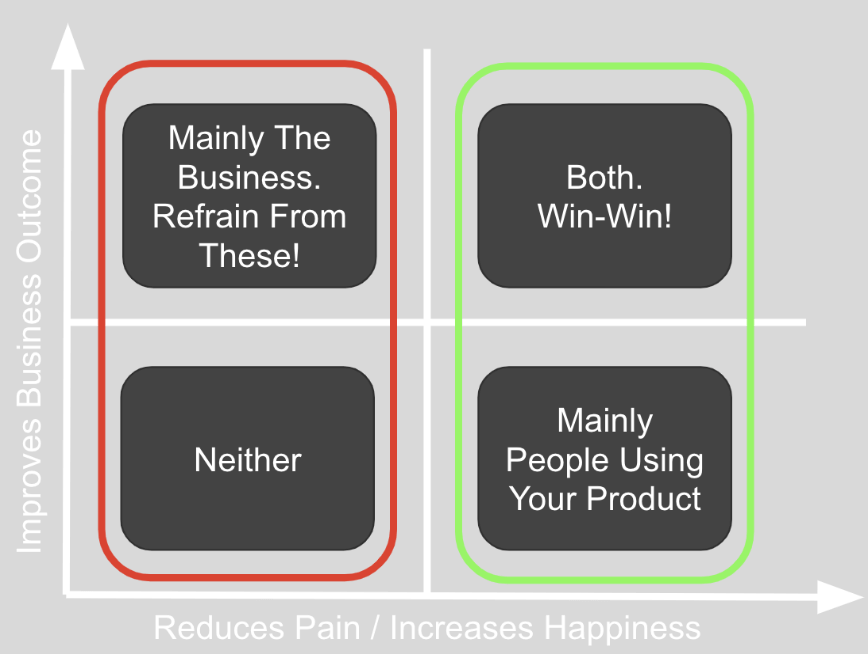Many product people before me have drawn comparisons between product management and parenting. As a parent and PM, I find myself comparing my treatment of customers to how I treat my kids. In my mind, this is actually a good thing.
Of course, there’s a big difference between saying you should treat someone like a kid vs. saying you should treat someone as if they were your kid. The former comes off as condescending while the latter suggests compassion, connection, and caring. Really, you want to “heart the heck out of” your customers. This post will focus on the benefits of treating your customers with the same level of compassion as you would your own children (or other important loved ones).
My children motivate me to become a better father and a better product manager. Over my years of both being a parent and a PM, I’ve noticed some key similarities between kids and customers. Both customers and kids:
- Are real people
- Are driven by emotions
- Think you can do anything
- Have difficulty articulating why they feel what they’re feeling
… just like you and me.
What Does it Mean to Treat a Customer Like Your Kid?
First off, you always stay tuned to their unmet needs, not just the words they say or use. Secondly, you practice honest compassion without any judgment. Lastly, you feel whatever they feel.
Let’s dig a little deeper into these points.
Focus on Why Over What or How
Customers will often give you their feedback in a very emotional state, especially if they’re not giving it in person. Typically, this happens because they’re in the middle of a task or situation that is directly impacting how they feel right there and then. This can cause them to provide direct, harsh, negative, or downright uncomfortable feedback. Sure, you could brush it off because the way it came across wasn’t pleasant or called for. But that would be judgemental, and you’d be missing the main learning. Instead, focus on why they are leaving that feedback, while still being cognizant of how they were feeling when they provided it, or what may have been at stake for them. You’ll be more likely to get to the source of the problem and uncover the core unmet need.
Empathy and Relationships Over Sympathy
When you’re being sympathetic to a customer’s issue, it’s the equivalent of seeing someone fall in the middle of the street and standing there with your arms crossed saying, “Man, that must hurt … I’m sorry for you.” Not very helpful.
When you’re being empathetic, it’s the equivalent of running up to that person and helping him up. That builds relationships and shows you care. If your kid falls down, you don’t hesitate to help them up, right? And with your kids, it’s all about nurturing lifelong relationships. Thinking the same of your customers is basically setting the gold standard for customer empathy and lasting cooperation.
People Over Users
Calling people like yourself “users” or “MAU” implicitly moves them away from you and makes them less, well, human. What if you referred to them as “MAP” (Monthly Active People) instead, for example? Could that even slightly change how you approach the problems they face with your product?
Other functions inside organizations have been taking the same approach for years (human resources turned into “people operations”) in an attempt to ensure we always remember who we are helping: people. And when you think of it that way, it simplifies how you approach their problems. It makes you a lot more empathetic to them since realistically, you probably have the same ones.
Some Useful Tools
How do you become an excellent “customer parent?” Below, I’ll discuss some helpful frameworks, formulas, and thought exercises that encourage customer empathy and compassion.
A Formula for Uncovering Unmet Needs
Sometimes you’ll receive lots of feedback from multiple channels, representing both your customers’ unmet needs and your organization’s untapped business opportunities. However, you may be unsure of how to represent or prioritize this feedback.
One approach I’ve found useful in the past is to calculate the opportunity score for each category (“theme”) of feedback. The concept is that an underserved need has high importance and low satisfaction levels. You can generally plot this on a 5-point Likert scale to see where the importance and current satisfaction levels converge for each theme. Also, you can use this at the market, product, and even feature levels to explore brand-new opportunities. You can compare your opportunity scores to your internal reference points or to others in the market. Once you have the data, make your calculations to get the relative importance and satisfaction numbers, which will eventually go into the following formula:
Opportunity = Importance + (Importance – Satisfaction)
From there, you can stack-rank based on the opportunity score and see what ends up on top. What nice about this approach is it helps to remove your own biases regarding where you think certain features should go or not. The outcome of the exercise is often pretty surprising (in a good way, of course)!
The “Emotional Solutioneering” Framework
One of the biggest lessons I’ve learned from my children when it comes to solving product and customer problems is to always start from emotion. Everything we do is triggered by emotion, often unconsciously, and then we justify those emotions logically.
One of the frameworks we’ve put in place in my current team for defining a problem statement works as follows:
-
- Identify pain points. Start by calling out the main pain points you can think of for the area you’re working on.
These might include:- I don’t understand what this is solving for me
- I don’t know how to use this feature
- I can’t find X when I need it urgently
- Map to emotions, Once you have the main pain points, try to call out the emotions you think they invoke in customers. For example:
- I don’t understand what this is solving for me – anger, hesitance, looking bad.
- I don’t know how to use this feature – stupidity, shame, incompetence, fear.
- I can’t find X when I need it urgently – frustration, missing features.
- Prioritize pain first. Prioritize the pain points that invoke the deepest and widest range of emotions.
- Identify pain points. Start by calling out the main pain points you can think of for the area you’re working on.
Sanity Check: Whose Problem Are You Actually Solving?
Even after letting emotions lead the way and prioritizing pain first, we’ve found it helpful to sanity check that you’re still focusing on the customer first and not just solving a business problem. We put together the following 2X2 to keep us honest:

Ideally, you want to be in the two right-hand quadrants, with the exception of internal architectural projects that may justify being in the top left quadrant. You never want to find yourself in the bottom left quadrant, of course.
“Worst Moment” Analysis
Finally, here is a quick exercise to encourage empathy and make some of your key performance indicators or success metrics more “human” and people-oriented. When considering challenges or issues your customers may face with your product, imagine the worst or more irritating potential outcome. Here are a couple of quick examples:
- Metric: Page load time → Missed opportunity. Worst moment: I can’t show my boss something super important right now.
- Metric: Crash rate → Missed opportunity. Worst moment: I can’t capture an incredible moment with my family swimming with unicorn dolphins.
Wrapping It All Up
As obvious as it may seem, imagine the people who are using your product are sensitive, emotional, real people with deep needs and wants, and who are the most dependent on you in your professional life. Because they really are. Build relationships and connections with them, especially when they’re not looking.
Treat them like they were your kids — with all the goodness and care that comes along with that.


